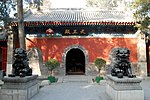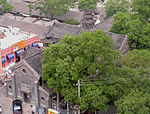Guang'anmen
Demolished buildings and structures in ChinaGates of BeijingNeighbourhoods of BeijingRoad transport in BeijingXicheng District

Guang'anmen, also known as the Gate of Expansive Peace, Guangningmen and Zhangyimen, was a city gate of old Beijing, constructed during the reign of the Jiajing Emperor (1521–1567) of the Ming Dynasty. This gate was part of Beijing's city wall, situated south-west of the city center and facing east. Guang'anmen served as a main entrance to Beijing.
Excerpt from the Wikipedia article Guang'anmen (License: CC BY-SA 3.0, Authors, Images).Guang'anmen
Xicheng District Guang'anmennei (首都功能核心区)
Geographical coordinates (GPS) Address Nearby Places Show on map
Geographical coordinates (GPS)
| Latitude | Longitude |
|---|---|
| N 39.889423 ° | E 116.349978 ° |
Address
100032 Xicheng District, Guang'anmennei (首都功能核心区)
Beijing, China
Open on Google Maps










